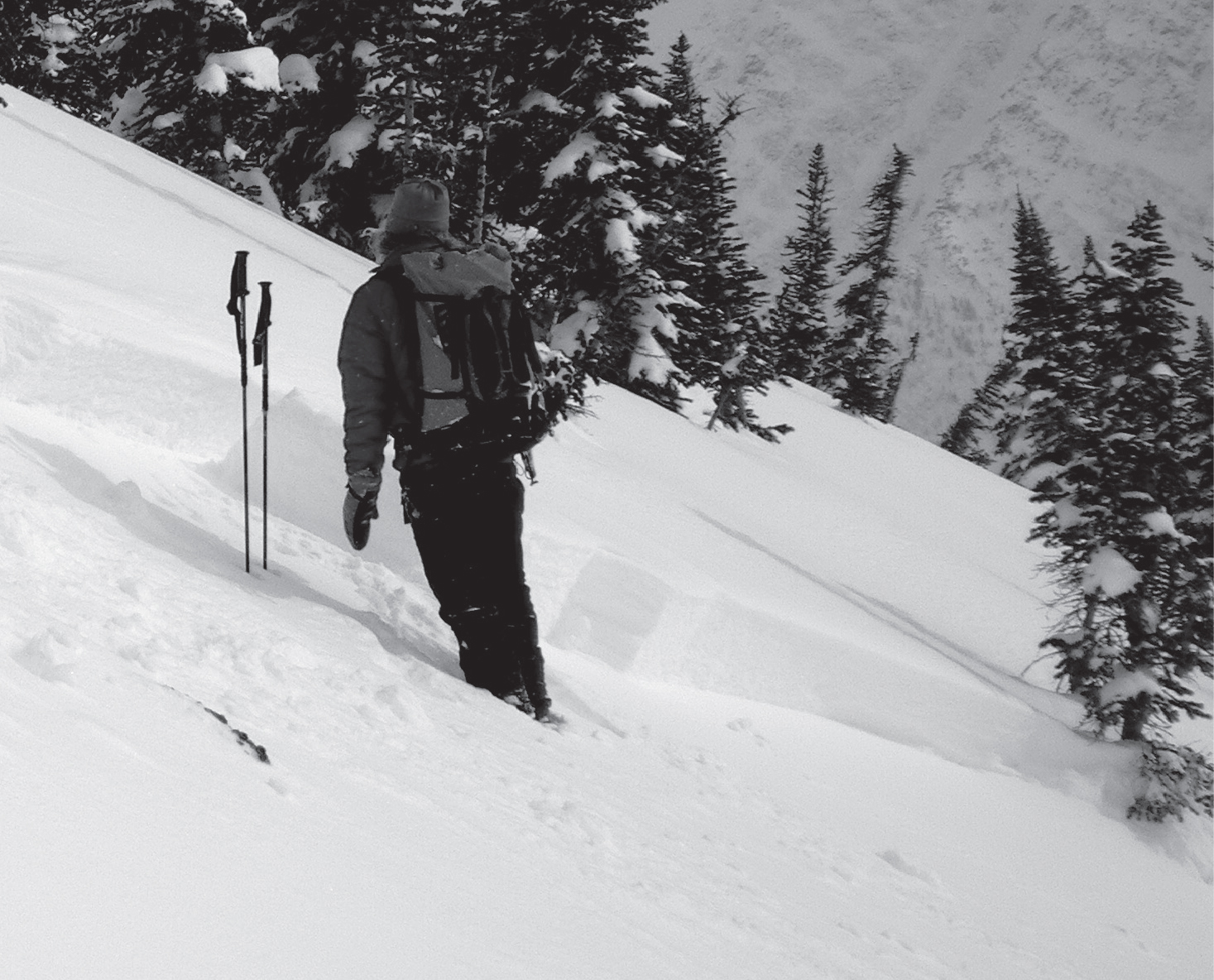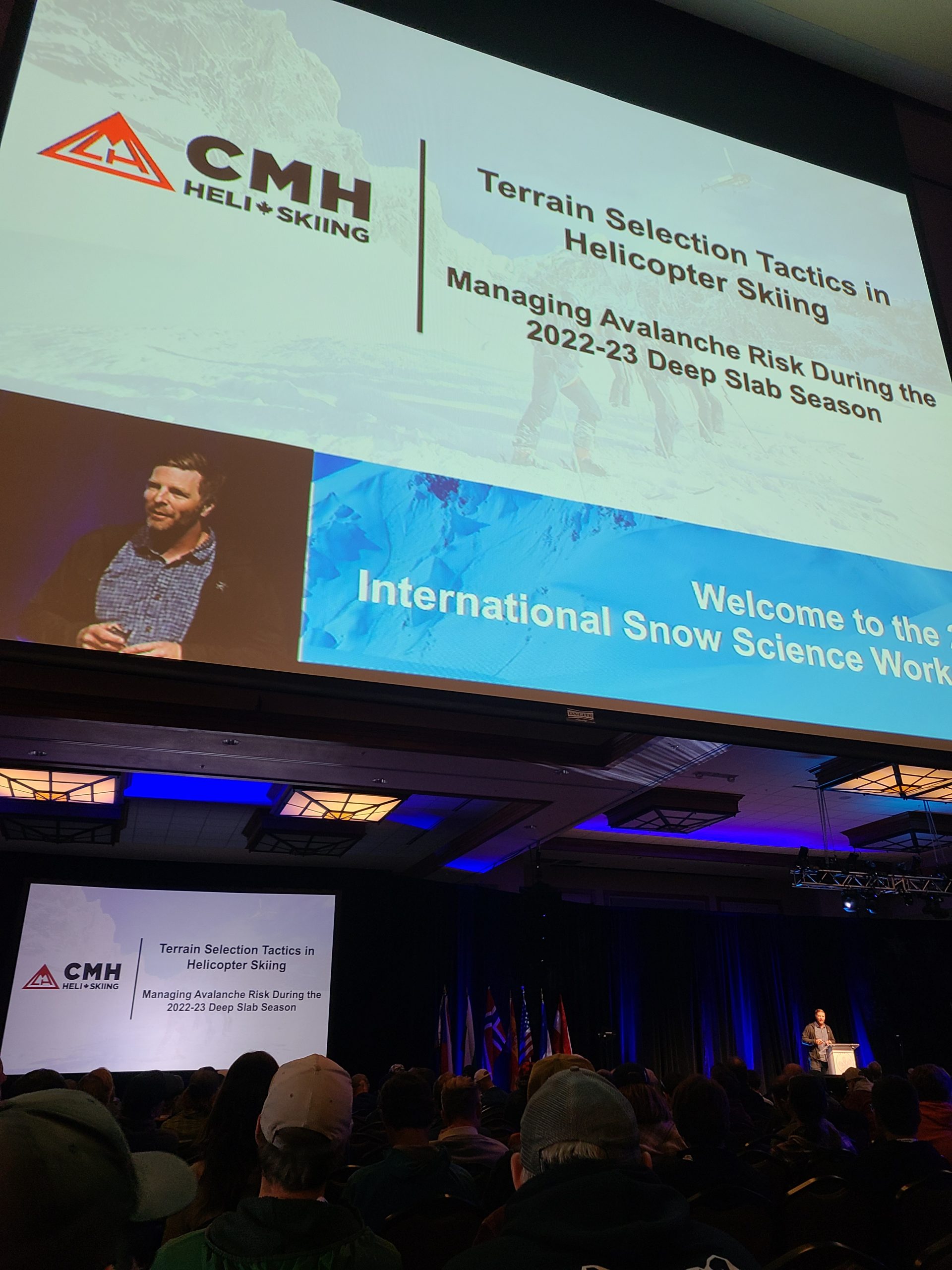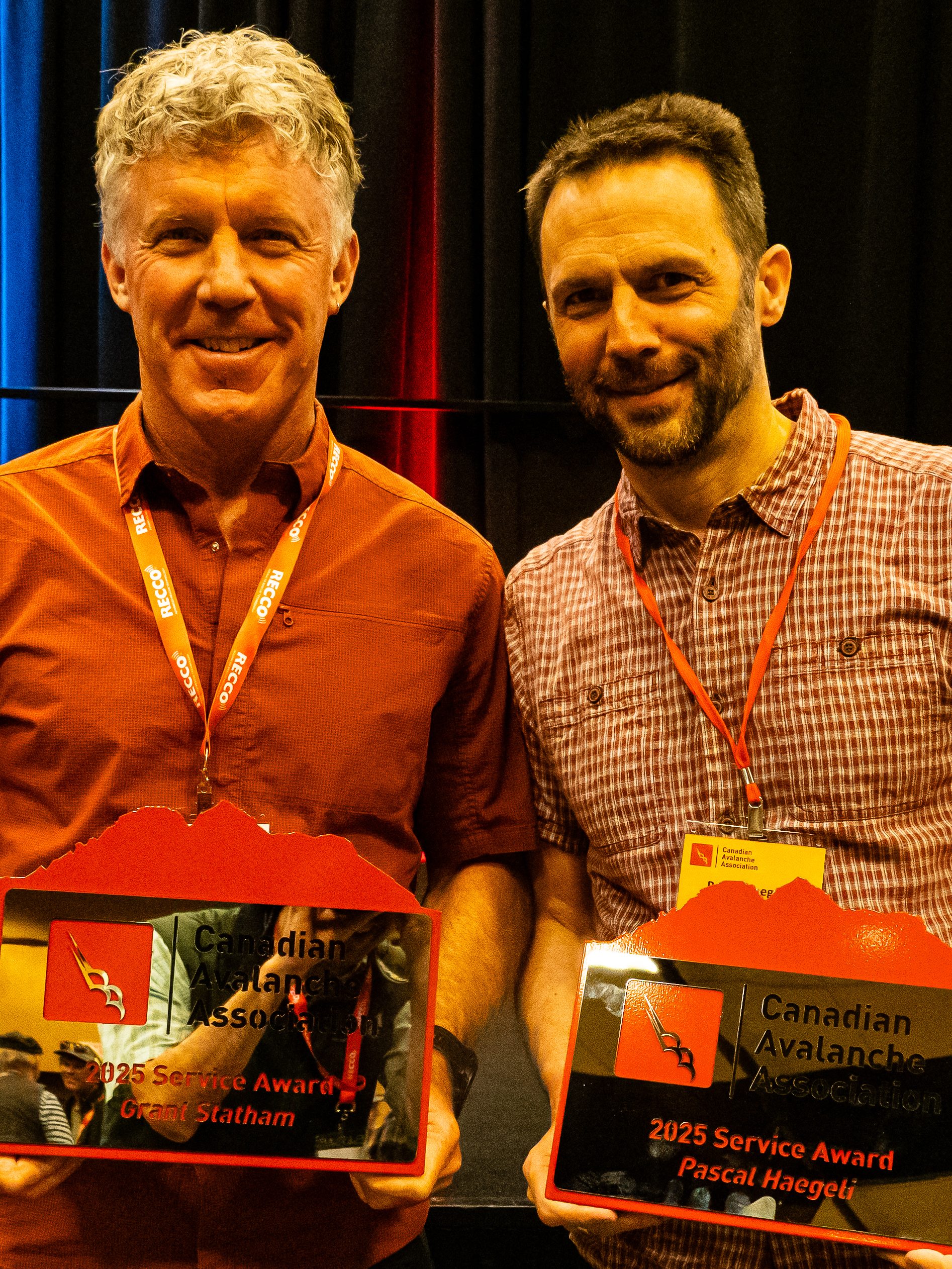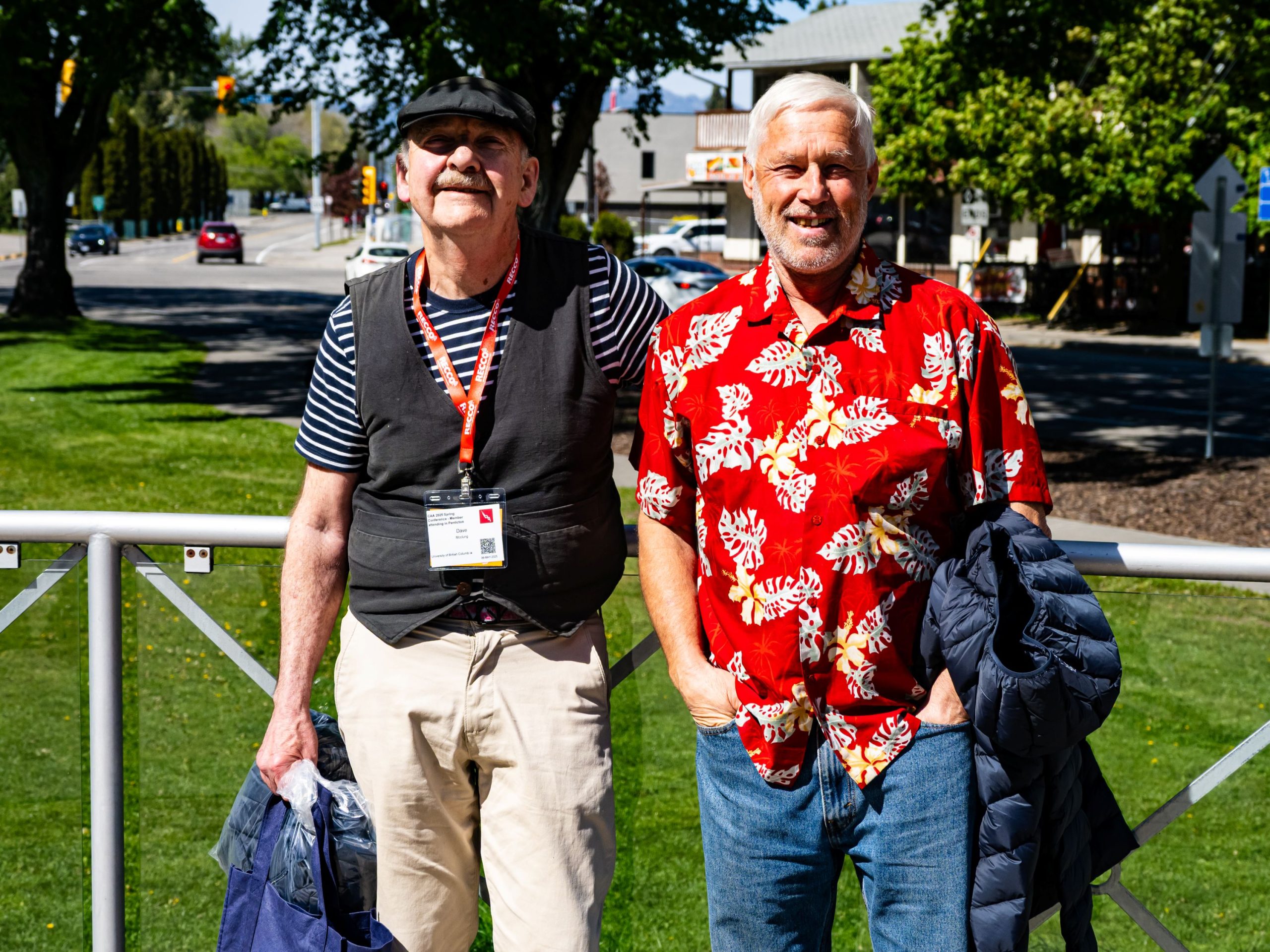By Thomas Exner and Bruce Jamieson
ASARC – Applied Snow and Avalanche Research, University of Calgary
Note: Occasionally, we will post older articles from The Avalanche Journal archives that may contain outdated information. We share them for historic purposes only. If you are interested in this topic, please seek out the latest research. This article was initially published in Avalanche.ca, Volume 84, Spring 2008
Many people associate snow pack warming with spring-like conditions, when snow temperatures are close to 0 C and the likelihood of wet avalanches increases rapidly as soon as the sun softens up the melt-freeze-crust that often forms during cool nights. This is a common scenario in spring, when signs of warming, such as relatively warm air temperatures, strong solar radiation, and moist surface snow are easy to observe. But, what happens to a cold, dry snow pack that warms up significantly at air temperatures below zero?
In this article we discuss a few concepts of stability changes caused by daytime warming and summarise results from reported avalanches mainly caused by solar warming of a dry snowpack. These cases are quite rare, but under the right conditions warming can be the significant factor decreasing stability. According to a Swiss study (Harvey and Signorell, 2002) in 20% of 128 avalanche accidents in the Swiss Alps, daytime warming was the only factor contributing to avalanching. On those days no significant amount of new snow or recent wind loading was reported. Of course, maybe in some of those cases there may have been just a lingering instability, which could have been triggered by a skier regardless of the warming. However, the 20% suggest a significant correlation to the influence of warming.

What are the sources of warming that can rapidly increase the temperature of near surface layers?
The main warming sources that effectively are able to increase avalanche danger are solar warming, rain, and warm, strong winds. Rain is probably the most efficient way of adding heat to the snowpack (Marshall and others, 1999). It destabilizes the snow pack in a short time, can penetrate down to deep layers, and affects all aspects. Luckily, mid-winter rain events are rare in alpine regions in most places in Western Canada. Warm, dry winds, such as the Chinook are known to cause rapid warming of the near surface layers and may reduce snow pack stability. But, these warm wind events are infrequent, except on the eastern slopes of the Canadian Rockies.
The most frequent cause of near surface warming seems to be direct solar radiation. It can warm up the upper layers of the snow pack rapidly within hours and affect the stability of the snowpack down to about 30 to 50 cm (McClung and Schaerer, 2006, p.38). By softening the surface layers, loads (e.g. skiers or snow boarders) may even affect deeper layers. Thin clouds may intensify the heating effect by trapping radiation between the snow pack and the clouds (greenhouse effect).
The effect of time
Usually, warming of a dry snowpack is associated with increased settlement of the snow pack, and non-persistent (storm snow) weak layers are believed to be stabilizing under these conditions. This seems to be the case as long as the settlement happens slowly and gradually (McClung and Schweizer, 1996). Settlement and creep are always connected with a deformation of the snowpack, and snow as a material can adjust to slow changes in deformation without damage. However, fast deformation, as sometimes observed during rapid warming events, can result in collapse of the snow micro-structure (bonds are breaking faster than new bonds are forming), and a layered snowpack may release slab avalanches.
So, slow warming and settlement of the snowpack usually promotes stability. But, of course, there is an exception to this rule. Imagine for example a surface hoar layer, buried under a layer of low density snow with low cohesion (Fig. 2). No matter how hard a skier, boarder or snowmobiler hits this layer there is no slab to release. But with ongoing settlement, even when slow and gradual, the overlying layer(s) will increase in stiffness and density (become “slabby”). Now it may not take a lot to trigger and propagate a fracture in the surface hoar layer, and release a slab avalanche. This process requires a pre-existing persistent weak layer, such as the surface hoar layer.
In most cases when rapid solar warming, within a few hours or so, increases avalanche danger the slab/weak layer combination is mostly already like a “loaded gun.” The warming speeds up the creep of the slab on the weak layer just enough to possibly trigger a natural slab avalanche. Keep in mind we are still talking about a dry, sub-freezing snowpack. Once the snow surface starts to melt we are dealing with moist or wet point releases, which are a different story not addressed in this article. However, there are few cases where rapid solar warming significantly decreased stability, even though an obvious weak layer was not observed. The following section summarizes the conditions when this phenomenon was observed.

Low density snow and rapid solar warming
According to the results of a survey conducted amongst 35 experienced avalanche practitioners in the fall of 2006, numerous reports of solar warming related avalanches followed a similar pattern. In all of these cases obvious signs of instability (shooting cracks, whumpfing and skier-triggered avalanches) developed during a short period of strong solar warming after the snow pack initially appeared to be stable and, interestingly, no obvious weak layer was observed initially. A few of these cases were reported by mechanised skiing operations, where a run was skied several times during the warming period. Snowpack observations ranged from no signs of instability on the first run to shooting cracks and triggered slabs within hours on the following runs. The following list summarises conditions, each of which were reported in a number of incidents.
- East to south-east facing slopes (35-40°)
- Air temperatures well below zero (in the -8° to -15°C range)
- Clear skies, strong solar radiation in the morning hours in March or April
- First sunny day after a storm
- Cold, low density near surface layer
- No signs of warming (snow surface still dry)
- Initially stable snowpack, no obvious weak layers
We assume that rapid solar warming and settlement stiffened up the near-surface layer and so turned into a releasable slab (Fig. 3). A buried, subtle storm snow layer may have turned into a reactive sliding surface with the stiffening slab on top. With ongoing warming this temporary stage of instability probably stabilizes subsequently due to strengthening of the storm snow layer. Potentially, the interface of the warmer and denser layer overlying the still colder and less dense layer may have acted as the weak layer. Attempts to model this interface with a numerical snowpack model have been inconclusive so far. The idea of a storm snow layer becoming the reactive weak layer seems to be more likely.
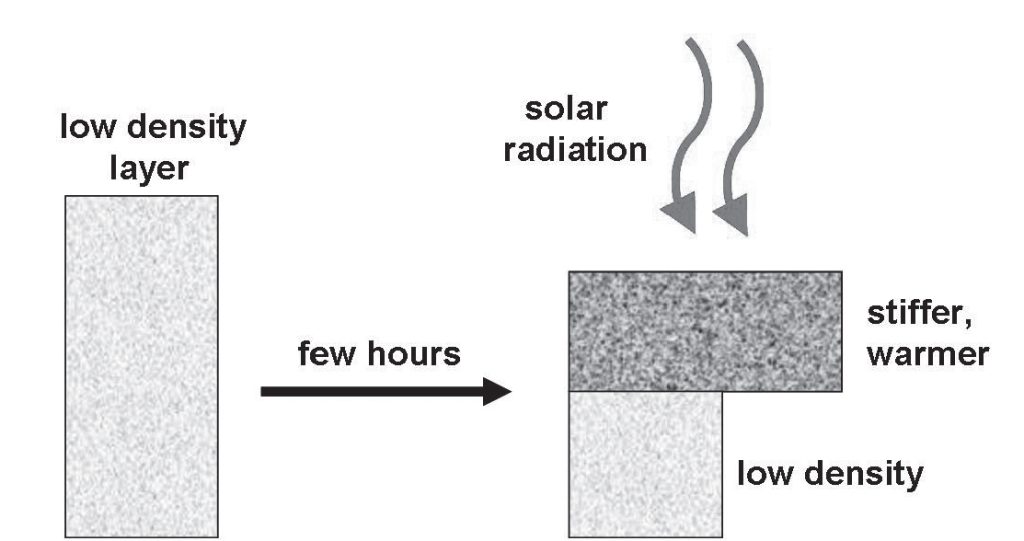
We set out to track down these warming events and gather more detailed data over a limited number of days during the winter of 2006/07. So far, we have not been able to observe this phenomenon. Even when conditions seemed right, we only observed the settlement and stiffening of the surface layer but could not fi nd any signs of decreasing stability. So, what happened? It seems like this scenario is a complex interaction of many factors, such as warming rate, temperature range, snowpack properties, presence of an initially subtle weak layer, slope angle, aspect, and so on, which is so far poorly understood. In some of our observations some clouds may have delayed the warming or snow temperatures were too high, softening the slab and preventing propagation.
Nevertheless, the reported cases seem to suggest that solar radiation can temporarily promote slab avalanching without a pre-existing obvious weak layer. The case where an obvious persistent weak layer (e.g. surface hoar, rain crust), with a stiffening layer on top, turns into a reactive slab is a more common scenario and easier to recognise, even though experienced people have been surprised by it. Once the slab on such a layer has formed, unstable conditions can prevail for quite a while. In most of the cases reported here, the temporary stage of increased avalanche danger may just last for a few hours or so. The storm snow layers, or perhaps the interface gains strength quite rapidly with ongoing settlement and warming.
Other recent observations
In this winter season of 2007/08, a number of natural slab avalanches released in January above ice climbs in the Rockies on steep sunny aspects. Most of these avalanches released in the first few days after a storm on a sunny day and air temperatures were well below zero. Usually, at this time of year it is quite uncommon that solar radiation releases slab avalanches. Perhaps the combination of the weak snowpack in the Rockies this winter and still sufficiently strong solar radiation on steep sunny aspects was a factor in releasing these avalanches. Given the weak, unstable snow pack even the low January sun provided enough warming to act as a trigger. In the spring time it is more common for avalanches above ice climbs to start as moist point releases and may eventually step down to a weak layer and release a slab avalanche.
Snowpack warming model – SWARM
Most of the above reported scenarios showed air temperatures well below the freezing point, and obvious clues such as a moist snow surface and snow balling were missing. Without many years of experience these warming conditions are hard to recognise and can easily be overlooked, but still can lead to a significant increase in avalanche danger. From field observations we know that only a few degrees difference in slope angle or aspect have a strong effect on the amount of heat the snow surface layers absorb. This winter for instance, we observed a sun crust on steep south-facing terrain above 40° or so on a cold day in January with air temperatures in the -15 to -20°C range. On parts of the slope with only a minor change in angle or aspect the snow surface was still dry.
Laura Bakermans, a former grad student with ASARC, developed a snow pack warming model (SWARM) based on extensive temperature measurements of near surface layers to evaluate the influence of solar radiation depending on slope angle, aspect and time of year (Bakermans, 2006). Of course, it is not only the amount of daytime warming possibly raising avalanche danger on warming days. There are many other contributing factors. However, solar daytime warming is often underestimated on cold days when signs of warming are not obvious. Experienced people may know through intuition, based on many years of experience, when warming effects come into play. SWARM may help to train your intuition and shorten this learning process. Hogarth (2001), in his book “Educating Intuition”, would describe avalanche terrain as a “wicked” learning environment, since feedback is not always immediate or obvious, and it can have high consequences. On days when warming may be an issue it is probably wise to leave a wider margin of safety. There is still a lot to learn about the interaction of daytime warming and slab avalanching. SWARM is freely available for download on the ASARC web page (http://www.schulich.ucalgary.ca/cgi-bin/ENG/TrackIt.pl?SWarm.xls). Feel free to contact us if you have any questions, suggestions or comments.
Acknowledgements
Many thanks to all guides and forecasters, who kindly shared their knowledge and experiences on warming-related avalanches.
References
Bakermans, L., B. Jamieson. 2006. Measuring near-surface snow temperatures changes over terrain. Proceedings of the International Snow Science Workshop in Telluride, Colorado, 377-386.
Harvey S., C. Signorell. 2002. Avalanche accidents in back country terrain of the Swiss alps: New investigations of a 30 year database. Proceedings of the International Snow and Science Workshop, Penticton, B.C. The Canadian Avalanche Association.
Hogarth, R.M. 2001. Educating intuition. The University of Chicago Press, Chicago, U.S.A., 357 pp.
Marshall H.P., H. Conway, L.A. Rasmussen. 1999. Snow densification during rain. Cold Regions Science and Technology, Volume 30, Issues 1-3, 35-46.
McClung, D.M. , J. Schweizer. 1996. Effect of snow temperatures on skier triggering of dry slab avalanches. Proceedings of the International Snow Science Workshop in Banff, Alberta. Canadian Avalanche Association, Revelstoke, BC, 113-117.
McClung, D.M., P.A. Schaerer. 2006. The Avalanche Handbook. The Mountaineers, Seattle, Washington, U.S.A., 342 pp.

